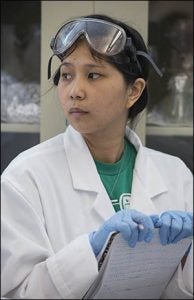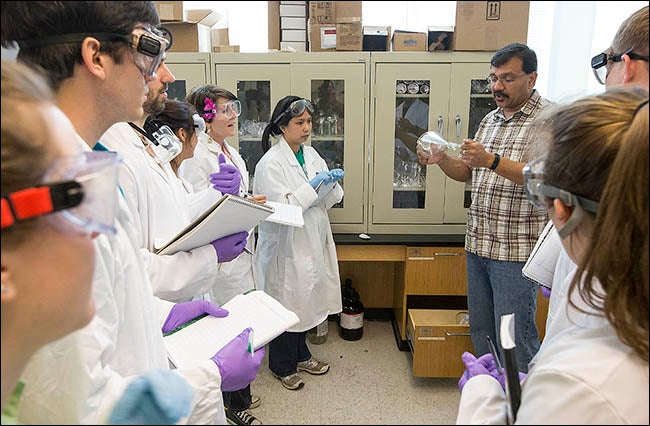CSI: TOWN COMMON
Students crack contamination cases in new geology course
Ten East Carolina University students are investigating hazardous waste sites this spring, seeking to uncover who or what is responsible for hazardous materials and pollution recently discovered at the Greenville Town Common.
A new environmental forensics course taught by geology professor Dr. Siddhartha Mitra is the first of its kind at ECU, funded through a National Science Foundation grant. Mitra’s students are examining the underground hazardous waste site by tracking the route of the chemicals and examining this site by sampling soils, water and air.
According to Mitra, there is hydrocarbon contamination in the soils in downtown Greenville, which seeps into the nearby creek and eventually ends up in the Tar River where it can affect wildlife.

ECU student Richelle Harvey listens to Mitra’s instructions before beginning work on the Town Common samples.
Mitra said residents who live near the site can smell the lingering contamination.
“You can still get a whiff of that little bit of history by crossing First Street going northbound to get over towards the boat ramp on the Tar,” Mitra said.
So far, Mitra said the students have “amassed a tremendous amount of theoretical and practical knowledge” about hazardous pollutants.
To determine who is responsible for Town Common contamination, students have learned about the history of the Greenville community and its businesses.
The class featured guest speakers from the city of Greenville, the N.C. Department of Environmental and Natural Resources, as well as an environmental hydrogeologist and an environmental lawyer.
“Learning about the legacy and history of the local community is an important aspect of the course,” Mitra said. “It enables students to make connections and learn what businesses have used or are using certain chemicals – in this case, hydrocarbon.”
Uncovering the truth surrounding a project like this could take years, Mitra said. However, the ECU students have already accumulated details about the contamination plume.
The students most recently began extracting water samples they collected from Town Creek in downtown Greenville. They will soon analyze sediment samples, Mitra said. Finally, they will compare what they find to historical contamination data from the site.
“We have not made any discoveries yet, but we will by the end of the semester,” Mitra said, adding that many people are unaware of the hazardous waste issues and their potential effects on a local economy.
Projects such as this protect human health and ecosystems. Mitra said many people are unaware of hazardous waste issues and their effects on a local community.
And if it can be proved who is responsible for the waste, Mitra said that company or industry would likely be responsible for paying for the cleanup.
“Overall, it is a great way for our students to get involved in the community in a different way,” Mitra said. “They are learning there is more to downtown Greenville than just eating and drinking.”

Dr. Siddhartha Mitra, right, speaks to an ECU geology class in environmental forensics before they begin examining samples from Greenville’s Town Common.